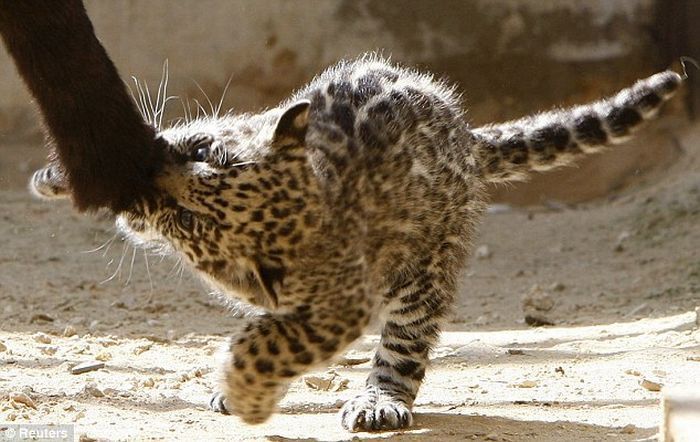|
|
Little Jaguar With Mom
|
In the past, conservation of jaguars sometimes occurred through the protection of jaguar "hotspots". These hotspots, described as jaguar conservation units, were large areas populated by about 50 jaguars. However, some researchers recently determined, to maintain a robust sharing of the jaguar gene pool necessary for maintaining the species, it is important that the jaguars are interconnected. To facilitate this, a new project, the Paseo del Jaguar, has been established to connect several jaguar hotspots.
• Jaguar in the United States
The only extant cat native to North America that roars, the jaguar was recorded as an animal of the Americas by Thomas Jefferson in 1799. There are multiple zoological reports of jaguar in California, two as far north as Monterey in 1814 (Langsdorff) and 1826 (Beechey). The coastal Diegueño (Kumeyaay people) of San Diego and Cahuilla Indians of Palm Springs had words for jaguar and the cats persisted there until about 1860. The only recorded description of an active jaguar den with breeding adults and kittens in the U.S. was in the Tehachapi Mountains of California prior to 1860. In 1843, Rufus Sage, an explorer and experienced observer recorded jaguar present on the headwaters of the North Platte River 30–50 miles north of Long's Peak in Colorado. Cabot's 1544 map has a drawing of jaguar ranging over the Pennsylvania and Ohio valleys. Historically, the jaguar was recorded in far eastern Texas, and the northern parts of Arizona and New Mexico. However, since the 1940s, the jaguar has been limited to the southern parts of these states. Although less reliable than zoological records, native American artefacts with possible jaguar motifs range from the Pacific Northwest to Pennsylvania and Florida.
Jaguars were rapidly eliminated by Anglo-Americans in the United States. The last female jaguar in the United States was shot by a hunter in Arizona's White Mountains in 1963. Arizona outlawed jaguar hunting in 1969, but by then no females remained and over the next 25 years only two male jaguars were found (and killed) in Arizona. Then in 1996, Warner Glenn, a rancher and hunting guide from Douglas, Arizona, came across a jaguar in the Peloncillo Mountains and became a jaguar researcher, placing webcams which recorded four more Arizona jaguars. None of the other four male jaguars sighted in Arizona in the last 15 years have been seen since 2006. Then, in 2009, a male jaguar named Macho B, died shortly after being radio-collared by Arizona Game and Fish Department (AGFD) officials in 2009. In the Macho B incident, a former AGFD subcontractor pleaded guilty to violating the endangered species act for trapping the cat and a Game and Fish employee was fired for lying to federal investigators. In 2011, a 200-pound male jaguar was photographed near Cochise in southern Arizona by a hunter after being treed by his dogs (the animal left the scene unharmed). A second 2011 sighting of an Arizona jaguar was reported by a Homeland Security border pilot in June 2011, and conservation researchers sighted two jaguars within 30 miles of the Mexico/U.S. border in 2010. In September 2012, a jaguar was photographed in the Santa Rita Mountains of Arizona, the second such sighting in this region in two years. Apparently this jaguar has been photographed numerous times over the past nine months through June, 2013.
|
|









